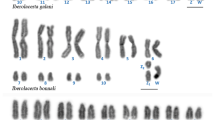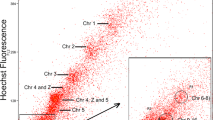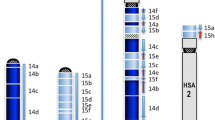Abstract.
A panel of human chromosome painting probes and bacterial and P1 artificial chromosome (BAC/PAC) clones were used in fluorescence in situ hybridization (FISH) experiments to investigate the chromosome conservation of the ring-tailed lemur (Lemur catta, LCA) with respect to human. Whole chromosome paints specific for human chromosomes 7, 9, 11, 13, 14, 17, 18, 20, 21, and X were found to identify a single chromosome or an uninterrupted chromosomal region in LCA. A large set of partial chromosome paints and BAC/PAC probes were then used to refine the characterization of the rearrangements differentiating the two karyotypes. The results were also used to reconstruct the ancestral Lemuridae karyotype. Lemur catta, indeed, can be used as an outgroup, allowing symplesiomorphic (ancestral) rearrangements to be distinguished from apomorphic (derived) rearrangements in lemurs. Some LCA chromosomes are difficult to distinguish morphologically. The 'anchorage' of most LCA chromosomes to specific probes will contribute to the standardization of the karyotype of this species.
Similar content being viewed by others
Author information
Authors and Affiliations
Additional information
Electronic Publication
Rights and permissions
About this article
Cite this article
Cardone, M., Ventura, M., Tempesta, S. et al. Analysis of chromosome conservation in Lemur catta studied by chromosome paints and BAC/PAC probes. Chromosoma 111, 348–356 (2002). https://doi.org/10.1007/s00412-002-0215-3
Received:
Revised:
Accepted:
Issue Date:
DOI: https://doi.org/10.1007/s00412-002-0215-3




